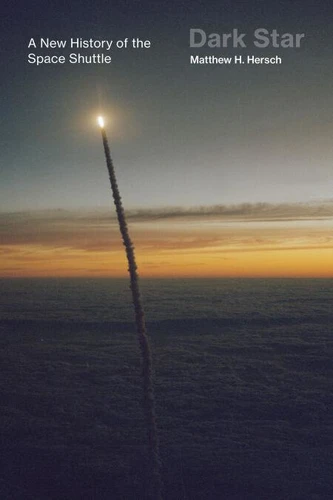Dark Star. A New History of the Space Shuttle
Par :Formats :
Disponible dans votre compte client Decitre ou Furet du Nord dès validation de votre commande. Le format ePub protégé est :
- Compatible avec une lecture sur My Vivlio (smartphone, tablette, ordinateur)
- Compatible avec une lecture sur liseuses Vivlio
- Pour les liseuses autres que Vivlio, vous devez utiliser le logiciel Adobe Digital Edition. Non compatible avec la lecture sur les liseuses Kindle, Remarkable et Sony
- Non compatible avec un achat hors France métropolitaine
 , qui est-ce ?
, qui est-ce ?Notre partenaire de plateforme de lecture numérique où vous retrouverez l'ensemble de vos ebooks gratuitement
Pour en savoir plus sur nos ebooks, consultez notre aide en ligne ici
- Nombre de pages328
- FormatePub
- ISBN978-0-262-37666-2
- EAN9780262376662
- Date de parution26/12/2023
- Protection num.Adobe DRM
- Taille26 Mo
- Infos supplémentairesepub
- ÉditeurThe MIT Press
Résumé
A captivating history of NASA's Space Transportation System-the space shuttle-chronicling the inevitable failures of a doomed design. In Dark Star, Matthew Hersch challenges the existing narrative of the most significant human space program of the last 50 years, NASA's space shuttle. He begins with the origins of the space shuttle: a century-long effort to develop a low-cost, reusable, rocket-powered airplane to militarize and commercialize space travel, which Hersch explains was built the wrong way, at the wrong time, and for all the wrong reasons.
Describing the unique circumstances that led to the space shuttle's creation by President Richard Nixon's administration in 1972 and its subsequent flights from 1981 through 2011, Hersch illustrates how the space shuttle was doomed from the start. While most historians have accepted the view that the space shuttle's fatal accidents-including the 1986 Challenger explosion-resulted from deficiencies in NASA's management culture that lulled engineers into a false confidence in the craft, Dark Star reveals the widespread understanding that the shuttle was predestined for failure as a technology demonstrator.
The vehicle was intended only to give the United States the appearance of a viable human spaceflight program until funds became available to eliminate its obvious flaws. Hersch's work seeks to answer the perilous questions of technological choice that confront every generation, and it is a critical read for anyone interested in how we can create a better world through the things we build.
Describing the unique circumstances that led to the space shuttle's creation by President Richard Nixon's administration in 1972 and its subsequent flights from 1981 through 2011, Hersch illustrates how the space shuttle was doomed from the start. While most historians have accepted the view that the space shuttle's fatal accidents-including the 1986 Challenger explosion-resulted from deficiencies in NASA's management culture that lulled engineers into a false confidence in the craft, Dark Star reveals the widespread understanding that the shuttle was predestined for failure as a technology demonstrator.
The vehicle was intended only to give the United States the appearance of a viable human spaceflight program until funds became available to eliminate its obvious flaws. Hersch's work seeks to answer the perilous questions of technological choice that confront every generation, and it is a critical read for anyone interested in how we can create a better world through the things we build.
A captivating history of NASA's Space Transportation System-the space shuttle-chronicling the inevitable failures of a doomed design. In Dark Star, Matthew Hersch challenges the existing narrative of the most significant human space program of the last 50 years, NASA's space shuttle. He begins with the origins of the space shuttle: a century-long effort to develop a low-cost, reusable, rocket-powered airplane to militarize and commercialize space travel, which Hersch explains was built the wrong way, at the wrong time, and for all the wrong reasons.
Describing the unique circumstances that led to the space shuttle's creation by President Richard Nixon's administration in 1972 and its subsequent flights from 1981 through 2011, Hersch illustrates how the space shuttle was doomed from the start. While most historians have accepted the view that the space shuttle's fatal accidents-including the 1986 Challenger explosion-resulted from deficiencies in NASA's management culture that lulled engineers into a false confidence in the craft, Dark Star reveals the widespread understanding that the shuttle was predestined for failure as a technology demonstrator.
The vehicle was intended only to give the United States the appearance of a viable human spaceflight program until funds became available to eliminate its obvious flaws. Hersch's work seeks to answer the perilous questions of technological choice that confront every generation, and it is a critical read for anyone interested in how we can create a better world through the things we build.
Describing the unique circumstances that led to the space shuttle's creation by President Richard Nixon's administration in 1972 and its subsequent flights from 1981 through 2011, Hersch illustrates how the space shuttle was doomed from the start. While most historians have accepted the view that the space shuttle's fatal accidents-including the 1986 Challenger explosion-resulted from deficiencies in NASA's management culture that lulled engineers into a false confidence in the craft, Dark Star reveals the widespread understanding that the shuttle was predestined for failure as a technology demonstrator.
The vehicle was intended only to give the United States the appearance of a viable human spaceflight program until funds became available to eliminate its obvious flaws. Hersch's work seeks to answer the perilous questions of technological choice that confront every generation, and it is a critical read for anyone interested in how we can create a better world through the things we build.



